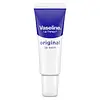What's inside
What's inside
 Benefits
Benefits

No benefits
 Concerns
Concerns

 Ingredients Side-by-side
Ingredients Side-by-side

Cera Microcristallina
Emulsion StabilisingOctyldodecanol
EmollientHydrogenated Polydecene
EmollientCetyl Palmitate
EmollientRicinus Communis Seed Oil
MaskingMyristyl Myristate
EmollientVp/Hexadecene Copolymer
Cetearyl Alcohol
EmollientPolyglyceryl-3 Diisostearate
EmulsifyingButyrospermum Parkii Butter
Skin ConditioningCaprylic/Capric Triglyceride
MaskingPentaerythrityl Tetraisostearate
EmollientVp/Eicosene Copolymer
C20-40 Alkyl Stearate
Skin ConditioningPanthenol
Skin ConditioningCopernicia Cerifera Cera
EmollientCera Alba
EmollientWater
Skin ConditioningGlycerin
HumectantLimonene
PerfumingLinalool
PerfumingBenzyl Alcohol
PerfumingBenzyl Benzoate
AntimicrobialCitral
PerfumingParfum
MaskingCera Microcristallina, Octyldodecanol, Hydrogenated Polydecene, Cetyl Palmitate, Ricinus Communis Seed Oil, Myristyl Myristate, Vp/Hexadecene Copolymer, Cetearyl Alcohol, Polyglyceryl-3 Diisostearate, Butyrospermum Parkii Butter, Caprylic/Capric Triglyceride, Pentaerythrityl Tetraisostearate, Vp/Eicosene Copolymer, C20-40 Alkyl Stearate, Panthenol, Copernicia Cerifera Cera, Cera Alba, Water, Glycerin, Limonene, Linalool, Benzyl Alcohol, Benzyl Benzoate, Citral, Parfum
 Reviews
Reviews

Ingredients Explained
These ingredients are found in both products.
Ingredients higher up in an ingredient list are typically present in a larger amount.
Parfum is a catch-all term for an ingredient or more that is used to give a scent to products.
Also called "fragrance", this ingredient can be a blend of hundreds of chemicals or plant oils. This means every product with "fragrance" or "parfum" in the ingredients list is a different mixture.
For instance, Habanolide is a proprietary trade name for a specific aroma chemical. When used as a fragrance ingredient in cosmetics, most aroma chemicals fall under the broad labeling category of “FRAGRANCE” or “PARFUM” according to EU and US regulations.
The term 'parfum' or 'fragrance' is not regulated in many countries. In many cases, it is up to the brand to define this term.
For instance, many brands choose to label themselves as "fragrance-free" because they are not using synthetic fragrances. However, their products may still contain ingredients such as essential oils that are considered a fragrance by INCI standards.
One example is Calendula flower extract. Calendula is an essential oil that still imparts a scent or 'fragrance'.
Depending on the blend, the ingredients in the mixture can cause allergies and sensitivities on the skin. Some ingredients that are known EU allergens include linalool and citronellol.
Parfum can also be used to mask or cover an unpleasant scent.
The bottom line is: not all fragrances/parfum/ingredients are created equally. If you are worried about fragrances, we recommend taking a closer look at an ingredient. And of course, we always recommend speaking with a professional.
Learn more about Parfum